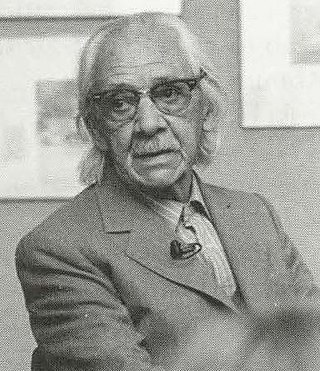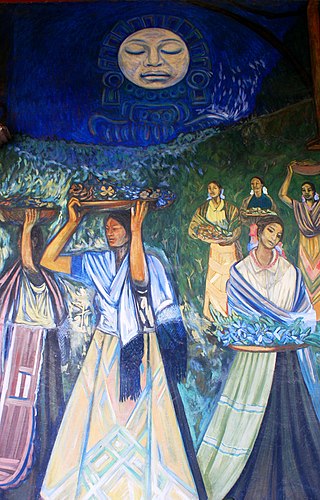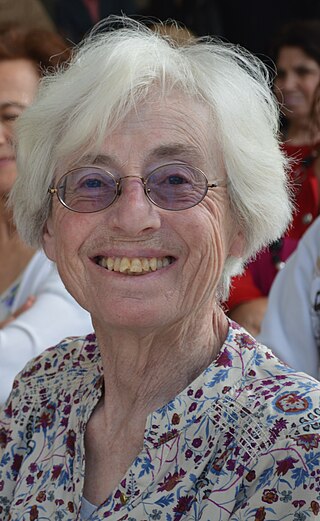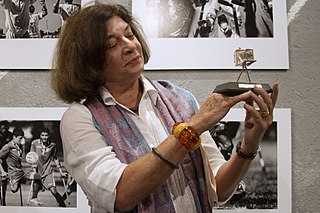
Manuel Álvarez Bravo was a Mexican artistic photographer and one of the most important figures in 20th century Latin American photography. He was born and raised in Mexico City. While he took art classes at the Academy of San Carlos, his photography is self-taught. His career spanned from the late 1920s to the 1990s with its artistic peak between the 1920s and 1950s. His hallmark as a photographer was to capture images of the ordinary but in ironic or Surrealistic ways. His early work was based on European influences, but he was soon influenced by the Mexican muralism movement and the general cultural and political push at the time to redefine Mexican identity. He rejected the picturesque, employing elements to avoid stereotyping. He had numerous exhibitions of his work, worked in the Mexican cinema and established Fondo Editorial de la Plástica Mexicana publishing house. He won numerous awards for his work, mostly after 1970. His work was recognized by the UNESCO Memory of the World registry in 2017.

Lola Álvarez Bravo was the first Mexican female photographer and a key figure in the post-revolution Mexican renaissance. Known for her high level of skill in composition, her works were seen by her peers as fine art. She was recognized in 1964 with the Premio José Clemente Orozco, by the State of Jalisco, for her contributions to photography and her efforts to preserve the culture of Mexico. Her works are included in the permanent collections of international museums, including the Museum of Modern Art in New York City.

Lesbia Claudina Vent Dumois is a contemporary Cuban visual artist, whose works include illustration, painting, art curation, and engraving. She does not specialize in any themes but is "interested in the everyday and historical references."
The Taller de Gráfica Popular is an artist's print collective founded in Mexico in 1937 by artists Leopoldo Méndez, Pablo O'Higgins, and Luis Arenal. The collective was primarily concerned with using art to advance revolutionary social causes. The print shop became a base of political activity and abundant artistic output, and attracted many foreign artists as collaborators.

José Chávez Morado was a Mexican artist who was associated with the Mexican muralism movement of the 20th century. His generation followed that of Diego Rivera, José Clemente Orozco and David Alfaro Siqueiros. Although Chávez Morado took classes in California and Mexico, he is considered to be mostly self-taught. He experimented with various materials, and was an early user of Italian mosaic in monumental works. His major works include murals at the Ciudad Universitaria, Secretaría de Comunicaciones y Transportes and Museo Nacional de Antropología in Mexico City as well as frescos at the Alhóndiga de Granaditas, which took twelve years to paint. From the 1940s on, he also worked as a cultural promoter, establishing a number of cultural institutions especially in his home state of Guanajuato including the Museo de Arte Olga Costa - José Chávez Morado, named after himself and his wife, artist Olga Costa.
Fanny Rabel, born Fanny Rabinovich, was a Polish-born Mexican artist who is considered to be the first modern female muralist and one of the youngest associated with the Mexican muralism of the early to mid 20th century. She and her family arrived to Mexico in 1938 from Europe and she studied art at the Escuela Nacional de Pintura, Escultura y Grabado "La Esmeralda", where she met and became friends with Frida Kahlo. She became the only female member of “Los Fridos” a group of students under Kahlo’s tutelage. She also worked as an assistant and apprentice to Diego Rivera and David Alfaro Siqueiros, painting a number of murals of her own during her career. The most significant of these is "Ronda en el tiempo" at the Museo Nacional de Antropología in Mexico City. She also created canvases and other works, with children often featured in her work, and was one of the first of her generation to work with ecological themes in a series of works begun in 1979.
Demián Flores Cortés is a contemporary Mexican artist who works in multiple media. He has worked in graphic arts, painting, serigraphy and more producing work which often mixes images from his rural childhood home of Juchitán with those related to modern Mexico City. It also often including the mixture of pop culture images with those iconic of Mexico’s past. Much of Flores’ work has been associated with two artists’ workshops he founded in Oaxaca called La Curtiduría and the Taller Gráfica Actual. This work has included events related to the 2006 uprising in Oaxaca and the restoration of an 18th-century church. His work has been exhibited in Mexico City, Europe, Guatemala and Cuba.
Francisco Díaz de León was a Mexican graphic artist, notable for pioneering much of modern Mexican graphic arts. He spent his childhood around books and when he studied art in Mexico City, he specialized in engraving and illustration. He spent his career illustrating books, magazines and more, reviving techniques such as dry point and introducing new techniques and styles such as the use of color and linoleum printing. He was also a noted arts education, directing several schools including the Escuela Mexicana de las Artes del Libro, which he founded. He was a founding member of the Academia de Artes and a member of the Salón de la Plástica Mexicana. In 1969 he received the Premio Nacional de Artes for engraving.

Alfredo Zalce Torres was a Mexican artist and contemporary of Diego Rivera, David Siqueiros and other better-known muralists. He worked principally as a painter, sculptor, and engraver, also taught, and was involved in the foundation of a number of institutions of culture and education. He is perhaps best known for his mural painting, typically imbued with "fervent social criticism". He is acclaimed as the first artist to borrow the traditional material of coloured cement as the medium for a "modern work of art". Publicity-shy, he is said to have turned down Mexico's Premio Nacional de Ciencias y Artes before finally accepting it in 2001. Before his death, Sotheby's described him as "the most important living Mexican artist up to date".

Leopoldo Méndez was one of Mexico's most important graphic artists and one of that country's most important artists from the 20th century. Méndez's work mostly focused on engraving for illustrations and other print work generally connected to his political and social activism. His most influential work was connected to organizations such as the Liga de Escritores y Artistas Revolucionarios and the Taller de Gráfica Popular creating propaganda related to the ideals of the Mexican Revolution and against the rise of Fascism in the 1930s. Despite his importance in 20th-century artistic and political circles, Méndez was a relatively obscure figure during his lifetime. The reasons for this generally relate to the fact that he believed in working collaboratively and anonymously for the good of society rather than for monetary gain and because the socialist and communist themes of his work fell out of favor with later generations. He has received posthumous recognition with a major biography, and scholarship considers him to be the heir to graphic artist José Guadalupe Posada.
Alberto Beltrán García was a Mexican graphic artist and painter known principally for his work with publications such as illustrations and political cartoons but he created a number of murals as well. He was born in the rough neighborhood of Tepito and began drawing for local publishers when he was a teenager. He attended the Escuela Nacional de Artes Plásticas where one of his teachers introduced him to the Taller de Gráfica Popular where he began his career in earnest. From the late 1940s until his death, he work with various publications, mostly newspapers, but he also did book illustrations as well. In his later career, he worked on a number of murals, especially in the state of Veracruz, which he had an affinity for. Despite winning a number of important awards for his work, he is relatively unknown even in Mexico, with collections of his work scattered among a number of institutions.

Adolfo Mexiac was a Mexican graphic artist, known principally for his politically and socially themed work, especially with the Taller de Gráfica Popular and with fellow graphic artist Leopoldo Méndez. He also painted several murals, the most important of which deals with the history of human law at the University of Colima. In 2011, a “national homage” was held for the artist at the Museo de la Estampa in Mexico City.
Enrique Bostelmann was a Mexican photographer known for his artistic work related to social problems as well as the use of objects and concepts from other artistic disciplines such as sculpture in his work. He did commercial work such as publicity, documentary and photographic reproductions of artwork. However, it was his personal projects in which he experimented with subjects, styles and techniques, which were exhibited in Mexico, other parts of Latin America, the U.S. and Europe from the start of his career in the 1960s until his death in 2003. His artistic work is basically of two types: the first exploring social issues and the second conceptualist, using common objects and concepts from other creative disciplines to create photographic images. Although he won no major awards for his work, he was selected as a judge for a number of competition and was inducted as a member of the Salón de la Plástica Mexicana.
Andrea Gómez y Mendoza was a Mexican graphic artist and muralist, a member of the Salón de la Plástica Mexicana.
Paulina Lavista is a Mexican photographer, noted for her controversial work which has tested the limits of the field. She is the daughter of a composer and a painter, beginning a career in modeling and cinema before moving into photographic work in the 1960s. She began with portrait work, with one of her first clients being longtime partner Salvador Elizondo, and later breaking into more artistic work with a series of nudes for the magazine Su Otro Yo. She has photographed many subjects from the Mexican art scene as well as images of people in every day activity, mostly in Mexico. She is a member of the Salón de la Plástica Mexicana.

Sarah Jimenez Vernis was a Mexican artist known for her political graphic work in the mid 20th century, especially with the Taller de Gráfica Popular, earning her membership in the Salón de la Plástica Mexicana. After her time with the Taller, her career shifted to teaching, and her work became mostly forgotten. However, there have been efforts to revive interest in it.
Lourdes Alaniz is a Mexican painter and graphic artist whose work has been recognized with exhibition in Mexico’s Salón de la Plástica Mexicana.

Colette Álvarez Urbajtel was a French-Mexican photographer, whose work, mostly of everyday life, was in black-and-white until 1990. She is the widow of Mexican photographer Manuel Álvarez Bravo, who taught her until she became a photographer in her own right. Her work has been exhibited extensively both in Mexico and abroad. It has been recognized with membership in the Salón de la Plástica Mexicana, two retrospectives and has been featured in several books and magazines.
Carmen Castilleja is a Mexican photographer whose work has been received several awards and a member of Mexico's Salón de la Plástica Mexicana

Christa Cowrie is a German-Mexican photographer, who began her career in photojournalism but is best known for her work documenting Mexico’s dance the theater events. Cowrie arrived in Mexico in 1963 and began her career in 1975 with the Excélsior newspaper. In 1977, she was one of the founders of the Unomásuno newspaper, also working to found one its supplements, focusing on ecological journalism. Her work began to shift towards photography dance and theater in the mid 1990s working with the Centro Nacional de las Artes. The archive she has created with this institution is one of the most important in Mexico documenting dance and theater. Her work has been recognized with membership in the Salón de la Plástica Mexicana.










